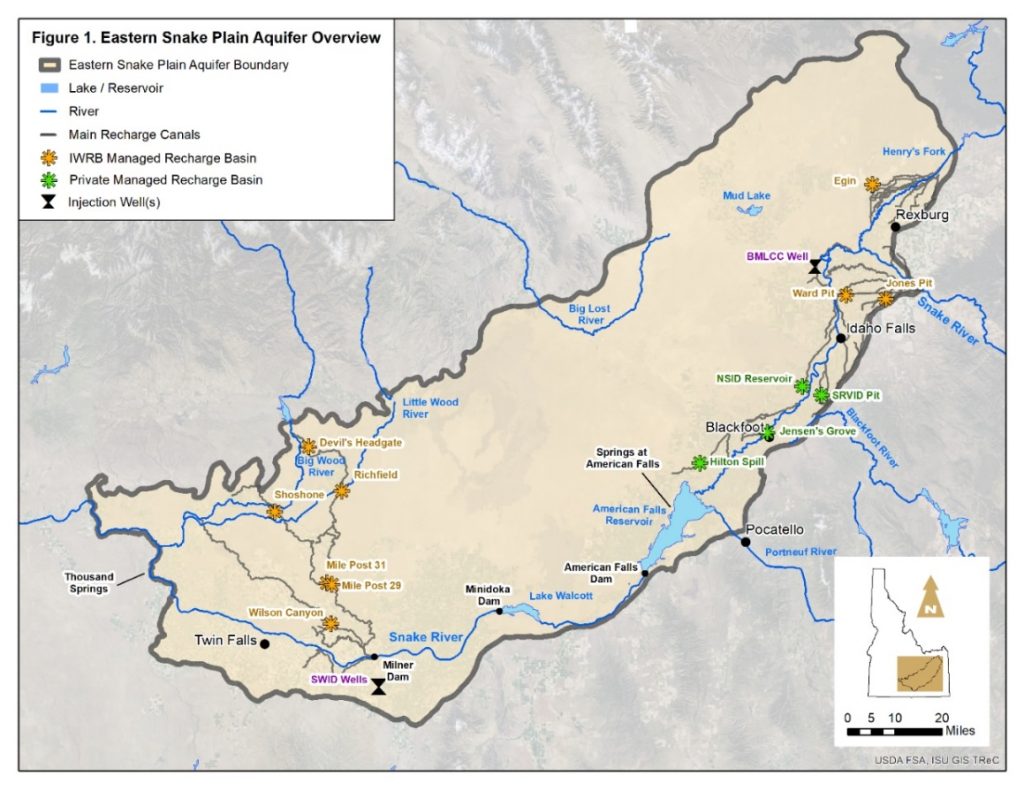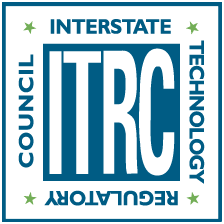Author: Wesley Hipke
Site Name: Eastern Snake Plain Aquifer (ESPA) MAR Program
Location: Southern Idaho
Operator(s): Idaho Water Resource Board (IWRB)
Permitting Agency(s): MAR facilities do not require permitting in Idaho; however, water rights with the beneficial use of recharge from Idaho Department of Water Resources (IDWR) is required to conduct recharge. Related to water quality injection wells, an underground injection control permit was required from IDWR, and Idaho Department of Environmental Quality (IDEQ) requires recharge basins to have an approved groundwater quality monitoring program.
Year Constructed: Pilot program 2009–2014; full-scale program started in 2014.
Purpose of MAR:
- Water supply resilience
- Use of floodwater (control of flood, agricultural)
- Protection of riparian ecosystems/maintenance of minimum streamflow
- Resilience/climate adaptation
Source Water:
- Rivers/streams/lakes/reservoirs
Water Quality:
- No pre- or post-treatment required
Conveyance of Source Water to MAR:
- Pump stations
- Diversion structures
- Canals/trenches/arroyo
- In-channel recharge
- Pipeline
Recharge Technology(s):
- Infiltration pond
- Wet well
- Bank filtration
- Sinkhole
Water Recovery and End Use:
- Aquifer recharge
- Irrigation
- Stream base flow
- Ecosystem/habit
Receiving Aquifer:
Eastern Snake Plain aquifer (ESPA)
Project Description
The ESPA Recharge Program is a state-run program in the Eastern Snake Plain region of Idaho. The program has been tasked with developing a MAR program to recharge an average of 250,000 acre-feet/year. To do so, the IWRB uses surface water rights and partners with canal and irrigation companies utilizing existing infrastructure to conduct MAR and deliver water to developed recharge basins and injection/recharge wells.
Benefits: The primary benefit is to mitigate the ESPA, which has been declining since the 1950s. The decline is a result of increased groundwater pumping, increased efficiencies in irrigation practices, and prolonged droughts. MAR is a key component to providing a sustainable water supply throughout the area. Stabilizing the aquifer has a direct impact on surface water flow, creating additional hydropower generation and environmental and recreational benefits.
Size of Project: ESPA covers over 10,000 acres. MAR occurs in canals (the largest being over 60 miles long), and individual recharge sites ranging from 1 acre to over 300 acres.
Current MAR Status: Since the start of the full-scale program in 2014, the program has recharged 2,300,00 acre-feet to date from numerous recharge sites.
Hydrogeological Setting
The ESPA primarily consists of layered basalt flows with discontinuous interbedded sedimentary deposits (Wood and Low 1986). These basalts can be highly fractured with extensive lava tubes and rubble zones throughout (Kuntz, Covington, and Schorr 1992). This causes hydraulic conductivities to be highly variable, ranging from 0.1 to 24,000 feet/day (Ackerman 1991). The ESPA also has a strong hydrological connection to the Snake River through connected reaches and large springs that discharge into the Snake River (Kjelstrom 1995).
Storage Potential: 200–300 million acre-feet
Geochemical Considerations: Agricultural runoff: total coliform, nitrate, nitrite, E. coli
Minerology: Basalt
Mobilization of Metals or Contaminants: Potential agricultural contaminants, such as total coliform, nitrate, nitrite, and E. coli, are present in conveyance systems but are greatly reduced from natural attenuation as water infiltrates through the vadose zone during recharge. No adverse effects to water quality in the aquifer have been observed.
Seasonal Variability: MAR activities generally begin after irrigation (October) and continue until April. When there is sufficient surface water to meet senior water rights, MAR activities can continue into the irrigation season.
Location Considerations: The IWRB has partnered with numerous irrigation companies to facilitate recharge, so recharge timing must be convenient for the irrigation companies.
Impacts to Proximal Facilities: No negative impacts to proximal facilities have been observed.
Effects on Current Water Users: Negative effects on current water users are minimal because the water right used for MAR is junior to most water users. MAR diversion does reduce the water available for hydropower in the winter months; however, MAR activities result in increasing surface water flow throughout the year.
Water Quality:
Source Water Quality: The Snake River and Big and Little Wood River provide the source water for this program. Sampling of the source water during MAR activities has detected no contaminants over MCL. No pretreatment was required.
Performance to Date
Project Metrics: Fall 2014 through spring 2023: 2,130,000 acre-feet recharged to date. Average since 2014: 236,700 acre-feet recharged per year.
Volume Water Recharged/Extracted: 2,377,000 acre-feet recharged, IWRB related natural flow and storage water from other entities.
Permitted vs. Actual Performance or Availability of Water: During “dry” years the program can currently recharge all the available water (approx. 500 cfs). During “wet” years water availability can range from 1,000 cfs to over 20,000 cfs. Currently, the program has a recharge capacity of 2,000–4,000 cfs, depending on when water is available.
Average Infiltration Rates/Seasonal Variations: If water is available before the irrigation season, canals can be used to conduct MAR, along with “off-canal” sites. However, once irrigation deliveries begin, only “off-canal” sites can be used. The infiltrations rates at “off-canal” sites can vary significantly, from 10 cfs up to 650 cfs.
Stakeholder Consideration
Water Planning: The IWRB worked with stakeholders to develop the ESPA Comprehensive Aquifer Management Plan (CAMP) to address the decline in the aquifer. The ESPA CAMP was adopted in 2009 and was designed to add an additional 600,000 acre-feet/year to the ESPA.
Community: The IWRB has significant, ongoing involvement with all the ESPA stakeholders.
Environmental Justice: The IWRB has established an Environmental Technical Working Group with key stakeholders to discuss and study potential environmental-related impacts associated with the IWRB’s MAR program.
Social Sustainability: This region accounts for between a quarter and a third of Idaho’s gross product. The design of the CAMP is to ensure this area has a sustainable water supply for the future.
Operational Constraints
Adjacent Business/Users: Agriculture and recreation
Mounding: Depth to groundwater varies significantly over the region from a few feet to over 300 feet. To date in the areas where MAR has occurred, mounding has not been an issue.
Contaminated Sites: N/A
Energy Requirements: To date, energy requirements are minimal, as most sites are gravity-fed.
Operational Costs: There is not a cost for the water that is recharged; however, there are conveyance and operational costs. Since the start of the full-scale program the cost has been $9.34 per acre-foot of water recharged. Adding in the additional capital cost for developing increased recharge capacity raises the total program cost to approximately $20 per acre-foot of water recharged.
Regulatory Consideration
Permitting Requirements: The doctrine of prior appropriation governs water rights in Idaho. Entities that wish to use surface or groundwater in Idaho must apply for a water right permit and demonstrate the water will be put to beneficial use. Idaho law explicitly recognizes groundwater recharge as a beneficial use of surface water. However, right of way permits from the Bureau of Land Management (BLM) have been required for many of the sites, since they reside on land managed by BLM. Additionally, IWRB must get the approval of a groundwater quality monitoring plan (GWQMP) from IDEQ to conduct recharge at basin MAR sites. Injection wells require a UIC permit from IDWR.
Water Rights: IWRB has recharge water rights and has applied for additional water rights on the Snake, Big Wood, and Little Wood rivers.
Accounting: Idaho does not have statutes for a recharge accounting or credit system. However, MAR can be used as part of a mitigation plan to reduce impacts for groundwater pumping on a yearly basis.
Description of Evaporation and Evapotranspiration: Evaporation and evapotranspiration (EET) are minimal because recharge occurs in the winter months when potential EET and actual EET are low.
How Are Losses Calculated and/ or Measured: EET losses are not calculated.
Meters and Calibration of Meters/Frequency: Several times a year
Reporting Agencies that Oversee the Accounting: Idaho Department of Water Resources
Contingency Plans
Exceedance for Water Quality/Aquifer Water Quality Parameters: Outlined in the approved groundwater quality monitoring program (GWQMP) or the UIC permit. Generally, if a sample is above a specified action level, the location is resampled. If still above the action level, the IWRB halts recharge activities and works with the regulating agency to develop a plan of action.
Emerging Contaminants: Currently, sampling is not required by either water quality regulating agency.
Structure Failures: The recharge sites are monitored daily. If a problem arises, water can be diverted to unused portions of the canal system or other canal systems can be used if they are available. Otherwise, the water is not diverted from the river.
Lessons Learned
Implementation: Stakeholders’ participation/support is crucial. Monitoring is extremely important to provide the data necessary to demonstrate the effectiveness/impact of the program and to adaptively manage the program to meet changing needs.
Operations & Maintenance
- Maintenance and operational techniques—Data loggers and gauging stations are checked frequently, and software is updated as needed.
- Planned maintenance schedule—Before and after recharge begins.
- Operator training—ESPA MAR program staff and canal companies provide training to their operators related to recharge activities.
- Equipment—Generator to purge wells for water quality sampling. All other equipment is owned and operated by the canal companies that deliver recharge water.
- Sedimentation—Sedimentation has not been a problem to date.
Funding Sources
IWRB receives money from the state of Idaho and the federal government. The IWRB will also share the cost of projects with partners, such as canal companies.
Supporting Figures/Drawings

Figure 1. Regional map.


